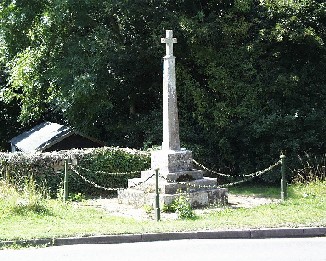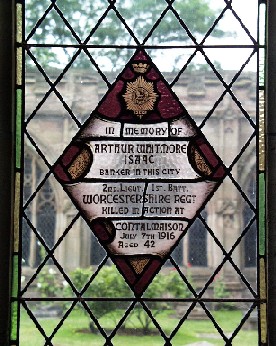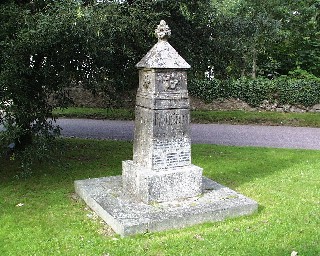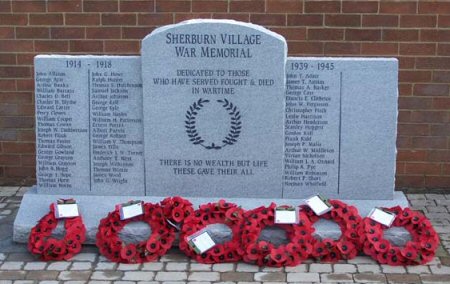![]() TOM MORGAN
TOM MORGAN
![]()
Such was the measure of the loss at the end of the war that it is not surprising that thoughts turned to remembrance. Up and down the country local communities began drawing up plans for their own, local memorials. In the United Kingdom, almost every town and village has one, and they come in many shapes and sizes. (Great Britain is not alone in this - France and Belgium are the same).
The decision to erect a memorial was often taken at very local level, with a committee of local worthies being entrusted with the job of raising funds, deciding on a location and, most important of all, gathering the list of names to be included. The local vicar would often be a committee member with, if the community was big enough, the Mayor taking the chairmanship. Other committee members often included the donor of the land on which the memorial was to be sited and, where a local wealthy family had decided to pay for the memorial, the family would be strongly represented too. In UK Local Government terms, things often moved surprisingly quickly, with the result that these days, it's often very difficult to unearth records of how a memorial was chosen and completed. It's also difficult to find out exactly who a memorial belongs to, as has often been discovered lately by people wishing to add a name, correct a mis-spelling or look into the possibility of some renovation work. In the case of one memorial near my home, the vicar of the church in whose land the memorial stands thought that the memorial was the property of the Royal British Legion branch a little way along the road. The Royal British Legion people, though, were not certain enough of their ownership to give permission for the names to be re-carved even though someone else was offering to pay. They thought that the now-defunct Town Council owned the memorial. The confusion exists because all three organisations, which must certainly have been involved in the planning of the memorial project in the 1920s, have failed to find any actual records of the proceedings.
Paying for the memorial was usually no problem, as just about everyone in a local community seemed to feel that it was only right and proper that there should be one. "Public subscription" was a popular method of paying for a memorial although it was not unknown for wealthy individuals to share the cost or for one individual alone to pay (in which case this individual would have almost total control over what the memorial would look like, where it would stand and how the names would be presented - it was a good way of ensuring that the name of the donor's officer son appeared near the top of the list, as all that was needed was an unopposed decision to record the names in rank order.)
A lot of thought went into deciding where the local war memorial would be sited. Often, the decision was taken to site the memorial where it could easily be seen - perhaps in a busy spot, where the members of the local community would see it as they went about their daily lives, a nice touch, bringing the war dead back home as it were, and giving them a place in the day-to-day life of their home area. In other places, often in larger towns, memorials were placed in public parks, linking remembrance with recreation and quiet relaxation. Churchyards (or inside the churches themselves) were another popular location, although it was sometimes necessary to bear in mind that not all those who were to be commemorated were of the Christian faith, which is why memorials are often placed just outside the churchyard boundaries so as not to offend the religious beliefs of families whose lost servicemen didn't embrace the Christian religion.
Deciding which names to record on a memorial seems to have been done in a variety of ways, according to local opinions, but certainly it seems that gathering the names was an important part of the process especially in larger communities where the committee overseeing the memorial project couldn't know the names of all local men who had died in the war.Certainly in my own very small town which nevertheless has five hundred names recorded on the war memorial, the local newspaper printed an appeal for details of the war dead, on behalf of the War Memorial Committee. The names thus gathered were included on the memorial and also in the town's "Book of Remembrance" which is kept in the library. The memorial has only names, but the Book of Remembrance has ranks, regiments and dates of death for each man too, although it contains many errors which must have resulted from a literal transcription of the information provided. There are soldiers recorded as having served in the Royal Artillery and Royal Engineers with the rank of "Private" instead of "Gunner" or "Sapper" and another "Private" is listed as having been in the Royal Navy. There are also many not-quite-right regimental names. It seems that inclusion on my local memorial depended on relatives putting a man's name forward. People do move away, however, and so there must be many men missed out. Certainly, there are lots of memorials up and down the country which have far fewer names listed than the number of men recorded as having lived in the place in "Soldiers Died in the Great War."
How to present the names on the memorial was the next problem to be tackled and the solutions were numerous. A common layout is to have the names listed in alphabetical order according to surname, and nothing to distinguish between one man and the next. Sometimes forenames will also be given, sometimes just initial letters.
Other memorials give the ranks of the dead servicemen commemorated, again in alphabetical order according to surname. Others give the names in rank order, with the highest ranks first and each rank division in alphabetical order by surname. Sometimes, especially on memorials having four faces, you will see one face devoted to each year of the war. At other places, details of bravery awards will also be given, usually by the addition of letters such as "MM", "MC" and so on after a man's name.
Less often, memorials give details of individual men's regiments, corps or ships, and date or even place of death. Very rarely, places of burial will also be given. In some places, it was decided to list the names of all the local men who served, including those who survived the war and in these cases, the dead are usually indicated by a cross or star or suchlike after their names.
Most local war memorials have the names carved in Roman Capital letters. The use of lower case or italic letters is quite unusual.
Purely local inscriptions introducing the names, or other inscriptions can't be quantified. They are what makes so many memorials truly local, just as many of the family inscriptions to be seen on Commonwealth War Graves Commission gravestones make them so individual and personal.
Finally - the form and style of the memorial was another important factor to be considered when deciding to set one up, and I've left this factor till last. There are so many interesting variations, and this is what makes war memorials so interesting to look out for. Pillars, plinths, crosses, statues, church gates, public parks, sports fields, community buildings, hospitals, schools - all these have been chosen as the means by which the dead of the Great War are remembered near their homes (usually with additions following the Second World War, of course). And the important thing is to remember them by name, and for ever. This why so many memorials (and most war cemeteries) include the words "Their Name Liveth for Evermore." I think it's important to take time out to stop and look at war memorials, and to read the names. I'm very happy to see many communities returning to an earlier practice, that of reading out the names during the annual Act of Remembrance in November. You can learn a lot about a community by looking at its war memorial. In the gallery which follows I want to show some of the different types, plus some of my own favourites.
 |
"Death is Swallowed up in Victory". The rather neglected little memorial in the village of Swyre, Dorset. It contains the names of just six men from the village who died in the Great War, but it has a link to the deaths or wounds of millions. At the nearby road-junction is a signpost pointing to the village of Puncknowle (pronounced "Punnel") which is just three-quarters of a mile away. One of the former residents of the Manor House, next to the church, was Sir Henry Shrapnel, who invented and gave his name to the devastating Shrapnel fragmentation shell, first used in the Crimean War and fired by the million in the Great War. Shrapnel balls from these air-burst shells can still be found lying on the ground in the battlefield areas today. |
 |
Churches are a good place to look for one-name memorials. This is one of many stained-glass panels added to the enclosing windows of the cloisters at Worcester Cathedral. |
Sometimes, memorials have a dual purpose, like this one beside the A3052 road at Rousdon, Devon. Such memorials don't always look like memorials. With the word "Rousdon" in large letters, this one looks at first like a village name-marker or a one-time water-fountain. In fact, it commemorates the thirteen workers from the Rousdon Estate who died in the war and doubles as a milepost - it is situated at a road junction and the names and distances to neighbouring villages are carved into the other three sides. |
 |

Not all village memorials are old. The one in Sherburn, County Durham, is brand new, having been inaugurated on Remembrance Sunday, November 11th 2007. The Sherburn Village War Memorial fund was started by two life long friends John Burrell & Kevin Stock and originated largely because of a deep interest in The Great War. The idea came about mainly because the village, unlike most villages surrounding it, never had an outdoor public monument. The memorial rolls indoors, in the village churches and schools were incomplete, largely due to the social, military and religious restrictions of the day. The new monument is civic and bears no resemblance to military or religious backgrounds that would have perhaps dictated terms back in the 1920s. Free from such limitations, and as a result of painstaking research over a period of three years, it has been possible to include around 24 missing men missing from the original rolls. The design was drawn up by John and Kevin themselves, and they consulted with a County Architect to finalise the surrounding memorial garden, before commissioning a mason chosen through a process of scrutinising previous work, overall costs and willingness to meet their deadlines.
.
![]()
 Copyright © Tom Morgan,
January, 2001
Copyright © Tom Morgan,
January, 2001
Return to the Hellfire Corner Contents Section